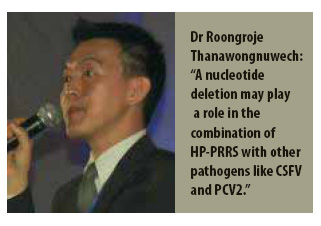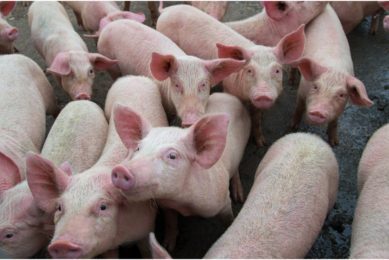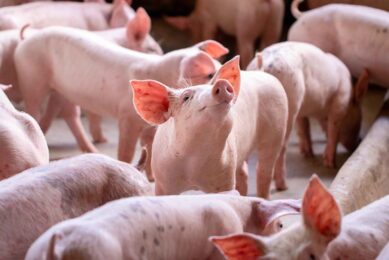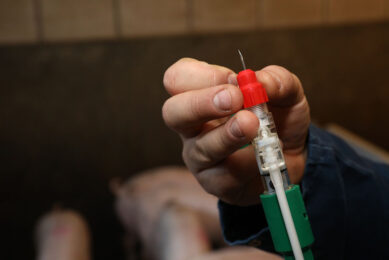APVS Congress gives update on highly pathogenic PRRS

Highly Pathogenic PRRS swept across China and South East Asia over the last couple of years. Thus, the disease has been studied extensively recently. At the APVS Congress, held in March, in Thailand, answers were given and some new questions were raised.
Apart from the recent Foot-and-Mouth Disease (FMD) outbreaks, there was one other current disease that received a lot of attention at the recent Asian Pig Veterinary Society (APVS) Congress, held in Pattaya, Thailand: Highly pathogenic PRRS (HP-PRRS).
Several presentations were held on the theme, which has been fascinating veterinary scientists, in order to gain more understanding on the topic. Some of these discussions evidently echo those around clearly defining disease patterns of PCV2 – e.g. PMWS and PCVAD, from a couple of years ago. Is it simply a new strain, is there an external trigger – and how should it be classified?Going back a couple of years, the first recording of its devastating effect was mentioned in China, in April 2006. In Jiangsu province, small- and middle size pig farms reported ‘swine high fever disease’. Causing high morbidity and mortality in pigs, PRRS was suspected, but not confirmed. Spreading rapidly throughout the country, the infection had a massive effect on Chinese pig production – leading to extremely high pork prices and inflation. As could be expected, the disease did not stop at China’s borders, but many countries in east and South East Asia were infected.
Strain
Some years ago, it was discovered that the atypical PRRS virus strains responsible for creating Porcine High Fever Syndrome or highly-pathogenic PRRS, belongs to the North American genotype. What all HP-PRRSV (PRRS virus) strains have in common is that one fraction in their gene is missing, usually referred to by veterinarian scientists as ‘a unique discontinuous deletion of 30 amino acids in Non-Structural Protein 2 (NSP2)’.
Now the question is – has the cause of the virulence thus been discovered? Are these ‘deletions’ causing this strain to be virulent? Dr Roongroje Thanawongnuwech, Chulalongkorn University, Thailand, addressed this particular question in his keynote lecture at the APVS Congress, when referring to research by Zhou and others in 2009. He said, “Although deletions in the NSP2 gene have previously been related to increased virulence of this particular HP-PRRSV strain, no virulence relation has been shown. It should be noted that only an in vivo study is able to differentiate PRRSV virulence among strains.”The deletion may have a synergistic effect in cooperation with other virus strains, he suggested. “A novel nucleotide deletion in NSP2 found in those Chinese isolates, initially linked to the virulence of the virus, may possibly attribute to a combination of HP-PRRS and other complicated pathogens such as Classical Swine Fever virus (CSFV), Porcine Circovirus (PCV2) and probably other additional agents.”
A similar conclusion was drawn by Dr Michihiro Takagi, from the Japanese National Institute of Animal Health, in Tsukuba. His team aimed to recreate Porcine High Fever Disease in 22 naïve and SPF-free pigs, using Vietnamese strains of the virus. Result – the pigs did indeed develop high fever – as the name suggests; all but one, however, lived. This did not match earlier results carried out with Chinese strains.
Hence, Dr Takagi concluded: “These results show the Vietnamese PRRSV isolates from 2007 and 2010 cause the highly virulent disease compared to classical PRRS. However, the high mortality in weaning pigs reported by the experimental infection with the Chinese PRRSV isolate, was not observed in this similar experiment. This suggests that the high mortality of pigs in Vietnam might be caused by other pathogens, with PRRSV as a major factor.”
Vietnam
The distribution of highly pathogenic PRRS is a topic that needs particular addressing anyway, as the outbreaks of HP-PRRS in Vietnam, Laos and Cambodia caused some further question marks. Dr Nguyen Tung, associated with the Vietnamese National Center for Veterinary Diagnosis in Hanoi, followed, observed and analysed HP-PRRS outbreaks in these countries and found some remarkable patterns.
Tung explained that the first occurrence of the HP-PRRS virus in Vietnam, is documented to have happened in March 2007. The team isolated and collected virus samples from a total of 213 cases ever since and found that essentially two different types of HP-PRRS have been present in the country. One was called the 2007 virus – as it had been responsible for the first outbreak; and the other, as it struck last year, the 2010 virus. Outbreaks in 2008 and 2009 were less severe and turned out to be varieties of the 2007 virus.Virus presence puzzled the team, however. Tung said he and his team found that in southern Vietnam (and neighbouring Cambodia), nowadays both strains can be found – in other words, the 2007 and 2010 type coexist. Oddly enough, in northern Vietnam and neighbouring Laos (and even one case in northern Thailand), the 2007 strain appears to have completely disappeared with the arrival of the 2010 strain – see Figure 1. Tung said it is not known how to explain this difference.
APVS Congress celebrates its fifth edition The biannual Asian Pig Veterinary Society (APVS) Congress had its fifth edition in Pattaya, Thailand and was themed ‘A healthy pig for a healthy life’. In total 850 participants from 23 countries attended the three-day event, held from 7-9 March, just prior to the VIV Asia in Bangkok, and also co-sponsored by Thai agrobusinesses Charoen Pokphand and Betagro. All in all, 73 oral papers were presented and 149 poster presentations. The event was opened by Theera Wongsamut, minister of agriculture for Thailand. The APVS’ six member states (South Korea, Philippines, China, Japan, Thailand and Vietnam) then followed, explaining their respective developments with regard to porcine health. Elsewhere in this edition of Pig Progress, attention is paid to what was said about Foot-and-Mouth Disease (FMD). The next edition of the APVS Congress will take place in Ho Chi Minh City, Vietnam, 6-8 November, 2013. |











